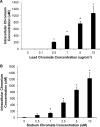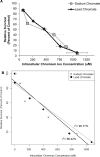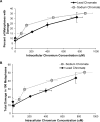The cytotoxicity and genotoxicity of particulate and soluble hexavalent chromium in leatherback sea turtle lung cells
- PMID: 29547730
- PMCID: PMC5915330
- DOI: 10.1016/j.aquatox.2018.03.003
The cytotoxicity and genotoxicity of particulate and soluble hexavalent chromium in leatherback sea turtle lung cells
Abstract
Hexavalent chromium [Cr(VI)] is a marine pollution of concern as recent studies show it has a global distribution, with some regions showing high Cr concentrations in marine animal tissue, and it is extensively used. Leatherback sea turtles (Dermochelys coriacea) are an endangered marine species that may experience prolonged exposures to environmental contaminants including Cr(VI). Human activities have led to global Cr(VI) contamination of the marine environment. While Cr(VI) has been identified as a known human carcinogen, the health effects in marine species are poorly understood. In this study, we assessed the cytotoxic and genotoxic effects of particulate and soluble Cr(VI) in leatherback sea turtle lung cells. Both particulate and soluble Cr(VI) induced a concentration-dependent increase in cytotoxicity. Next, using a chromosome aberration assay, we assessed the genotoxic effects of Cr(VI) in leatherback sea turtle lung cells. Particulate and soluble Cr(VI) induced a concentration-dependent increase in clastogenicity in leatherback sea turtle lung cells. These data indicate that Cr(VI) may be a health concern for leatherback sea turtles and other long-lived marine species. Additionally, these data provide foundational support to use leatherback sea turtles as a valuable model species for monitoring the health effects of Cr(VI) in the environment and possibly as an indicator species to assess environmental human exposures and effects.
Keywords: Chromate; Cytotoxicity; Genotoxicity; Hexavalent chromium; Leatherback sea turtle; Marine pollution.
Copyright © 2018 Elsevier B.V. All rights reserved.
Conflict of interest statement
The authors claim no conflict of interests.
Figures









Similar articles
-
A comparison of particulate hexavalent chromium cytotoxicity and genotoxicity in human and leatherback sea turtle lung cells from a one environmental health perspective.Toxicol Appl Pharmacol. 2019 Aug 1;376:70-81. doi: 10.1016/j.taap.2019.05.013. Epub 2019 May 18. Toxicol Appl Pharmacol. 2019. PMID: 31108106 Free PMC article.
-
Comparative cytotoxicity and genotoxicity of soluble and particulate hexavalent chromium in human and hawksbill sea turtle (Eretmochelys imbricata) skin cells.Comp Biochem Physiol C Toxicol Pharmacol. 2015 Dec;178:145-155. doi: 10.1016/j.cbpc.2015.09.013. Epub 2015 Oct 9. Comp Biochem Physiol C Toxicol Pharmacol. 2015. PMID: 26440299 Free PMC article.
-
Hexavalent chromium is cytotoxic and genotoxic to hawksbill sea turtle cells.Toxicol Appl Pharmacol. 2014 Sep 1;279(2):113-8. doi: 10.1016/j.taap.2014.06.008. Epub 2014 Jun 19. Toxicol Appl Pharmacol. 2014. PMID: 24952338 Free PMC article.
-
Assessment of the mode of action for hexavalent chromium-induced lung cancer following inhalation exposures.Toxicology. 2014 Nov 5;325:160-79. doi: 10.1016/j.tox.2014.08.009. Epub 2014 Aug 28. Toxicology. 2014. PMID: 25174529 Review.
-
Chromium (III) and chromium (VI) as important players in the induction of genotoxicity - current view.Ann Agric Environ Med. 2021 Mar 18;28(1):1-10. doi: 10.26444/aaem/118228. Epub 2020 Mar 10. Ann Agric Environ Med. 2021. PMID: 33775062 Review.
Cited by
-
A Novel Ex Vivo Approach Based on Proteomics and Biomarkers to Evaluate the Effects of Chrysene, MEHP, and PBDE-47 on Loggerhead Sea Turtles (Caretta caretta).Int J Environ Res Public Health. 2022 Apr 5;19(7):4369. doi: 10.3390/ijerph19074369. Int J Environ Res Public Health. 2022. PMID: 35410049 Free PMC article.
-
Combined effects of biochar and biodegradable mulch film on chromium bioavailability and the agronomic characteristics of tobacco.Sci Rep. 2024 Mar 22;14(1):6867. doi: 10.1038/s41598-024-56973-8. Sci Rep. 2024. PMID: 38514728 Free PMC article.
-
Carcinogenic Mechanisms of Hexavalent Chromium: From DNA Breaks to Chromosome Instability and Neoplastic Transformation.Curr Environ Health Rep. 2024 Dec;11(4):484-546. doi: 10.1007/s40572-024-00460-9. Epub 2024 Oct 28. Curr Environ Health Rep. 2024. PMID: 39466546 Review.
-
Prolonged particulate hexavalent chromium exposure induces RAD51 foci inhibition and cytoplasmic accumulation in immortalized and primary human lung bronchial epithelial cells.Toxicol Appl Pharmacol. 2023 Nov 15;479:116711. doi: 10.1016/j.taap.2023.116711. Epub 2023 Oct 5. Toxicol Appl Pharmacol. 2023. PMID: 37805091 Free PMC article.
-
A comparison of particulate hexavalent chromium cytotoxicity and genotoxicity in human and leatherback sea turtle lung cells from a one environmental health perspective.Toxicol Appl Pharmacol. 2019 Aug 1;376:70-81. doi: 10.1016/j.taap.2019.05.013. Epub 2019 May 18. Toxicol Appl Pharmacol. 2019. PMID: 31108106 Free PMC article.
References
-
- Bickler PE, Buck LT. Hypoxia tolerance in reptiles, amphibians, and fishes: life with variable oxygen availability. Annu Rev Physiol. 2007;69:145–170. - PubMed
-
- Chowdhury AR, Mitra C. Spermatogenic and steroidogenic impairment after chromium treatment in rats. Indian J Exp Biol. 1995;33(7):480–484. - PubMed
-
- Davenport J, Balazs GH. ‘Fiery bodies’ – Are Pyrosomas an important component of the diet of leatherback turtles? British Herpetological Society Bulletin. 1991;37:33–38.
MeSH terms
Substances
Grants and funding
LinkOut - more resources
Full Text Sources
Other Literature Sources

